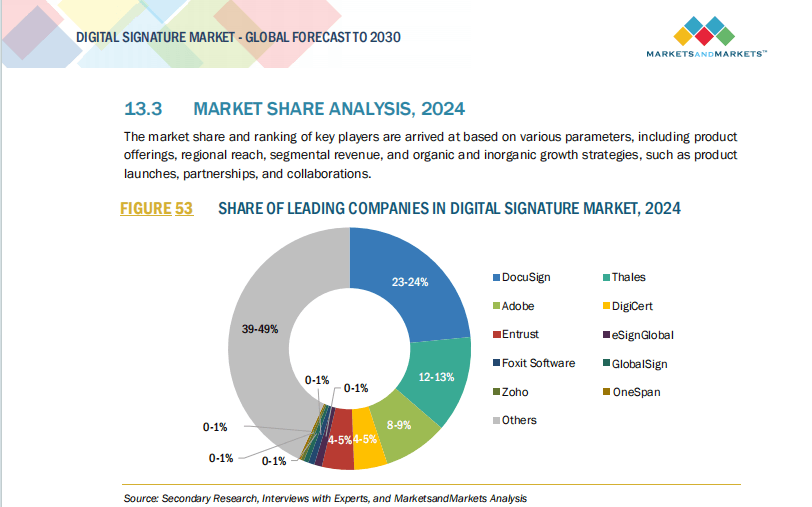WhatsApp or email with our sales team or get in touch with a business development professional in your region.
Global Digital Signature Market Landscape and Growth Trajectory





Over the past decade, the digital signature industry has evolved from a compliance-driven niche to a strategic enabler of global commerce and digital transformation. This article offers an in-depth analysis of this theme, weaving together data-backed insights from MarketsandMarkets, Grand View Research, Fortune Business Insights, and other leading sources. The narrative explores historical context, regulatory evolution, adoption barriers, and innovation milestones, providing executives, policymakers, and investors with a comprehensive understanding of this rapidly expanding ecosystem.

Historically, the adoption of digital signatures began with pioneering regulations such as the ESIGN Act in the United States (2000), which gave digital signatures legal equivalence to handwritten signatures. Europe’s eIDAS Regulation further standardized practices across EU member states, laying the foundation for interoperability and cross-border trade facilitation. The COVID-19 pandemic was a pivotal moment for this industry, with enterprises around the world transitioning to remote work, accelerating the need for secure, scalable, and legally binding digital transaction methods.
Data from MarketsandMarkets indicates that the global digital signature market grew from USD 1.89 billion in 2019 to USD 9.93 billion in 2024, with projections estimating USD 70.2 billion by 2030, maintaining a CAGR of approximately 39%. Grand View Research corroborates this trend, reporting that adoption is particularly strong in financial services, government, healthcare, and legal sectors, where compliance requirements and security concerns are paramount. Asia-Pacific stands out as the fastest-growing region, with projections of a 40.1% CAGR between 2025 and 2030, fueled by China’s strong regulatory framework, India’s digitalization initiatives, and Southeast Asia’s expanding e-commerce ecosystem.
One of the most significant trends driving growth is the shift toward cloud deployment models. The flexibility, cost-efficiency, and scalability of Software-as-a-Service (SaaS) offerings make them ideal for SMEs and enterprises with global operations. Reports highlight that cloud deployments are growing at over 41% CAGR, while on-premise solutions, though still favored by high-security industries, see slower growth. Vendors are increasingly investing in hybrid architectures to cater to organizations navigating diverse compliance environments. The integration of blockchain technology has strengthened document authenticity verification, while AI and machine learning applications are improving fraud detection, automating contract analysis, and enabling predictive risk management.
In addition to technology, market consolidation is reshaping the competitive landscape. Mergers and acquisitions by companies like DocuSign, Adobe, and Foxit signal a strategic focus on expanding product portfolios and geographic reach. Emerging vendors from Asia, such as those based in China and Singapore, are leveraging regional strengths, regulatory alignment, and cost advantages to penetrate international markets. This diversification has accelerated innovation, giving rise to multi-feature platforms that integrate e-signatures with identity verification, document management, and enterprise workflow automation.
As businesses adapt to hybrid work models, digital signatures are becoming critical to enabling borderless commerce. Governments are also scaling their reliance on these technologies for e-governance initiatives, enabling secure citizen services and paperless bureaucratic processes. The convergence of digital identity systems, cybersecurity, and zero-trust frameworks underpins this trend, driving a paradigm shift in how trust is established online.
Looking ahead, the market’s trajectory will be shaped by three major factors: regulatory harmonization, investment in infrastructure, and adoption of AI-enhanced solutions. Countries are increasingly collaborating to recognize digital signatures across borders, facilitating trade and reducing legal ambiguity. Enterprises are investing in security-first cloud solutions to protect sensitive data while meeting GDPR, eIDAS, and local data residency laws. Meanwhile, AI and blockchain will continue to create opportunities for automation, trust enhancement, and advanced analytics, making digital signatures an indispensable pillar of the global digital economy.
For decision-makers, this article underscores that digital signatures are no longer optional. They represent a cornerstone of the next phase of digital transformation, reshaping workflows,

Shunfang
Head of Product Management at eSignGlobal, a seasoned leader with extensive international experience in the e-signature industry.
Follow me on LinkedIn
Get legally-binding eSignatures now!
30 days free fully feature trial
Business Email
Get Started
 Only business email allowed
Only business email allowed
Latest Articles


